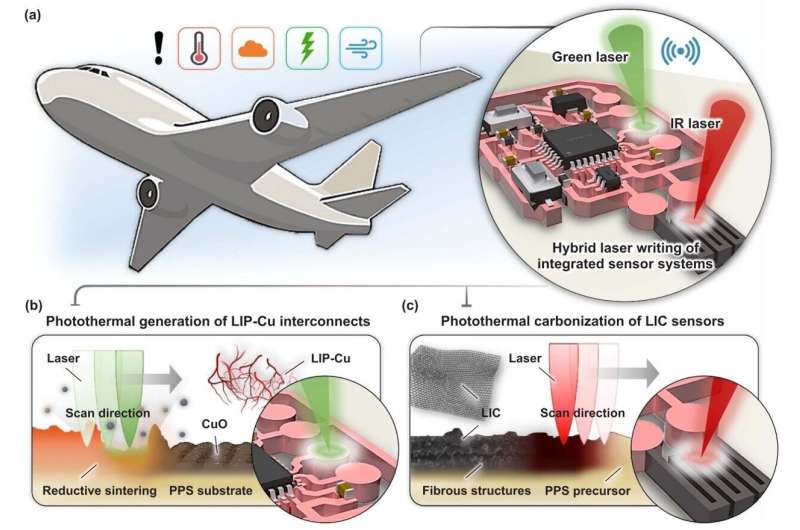
September 5, 2024 by International Journal of Extreme Manufacturing
Collected at: https://techxplore.com/news/2024-09-hybrid-laser-technique-copper-oxidation.html
Prof. Kaichen Xu and his coworkers from Zhejiang University have developed a novel method to integrate sensor systems directly into engineering thermoplastics using laser technology. Their breakthrough offers the potential for improved safety and extended service life of critical equipment across various industries, including aerospace, automotive, health care, and transportation.
The research, published in the International Journal of Extreme Manufacturing, introduces a hybrid laser direct writing technique that enables the creation of functional copper interconnects and carbon-based sensors within a single, integrated system. It allows for real-time temperature monitoring over extended periods, ensuring optimal performance and reliability.
The Xu research group at ZJU is an interdisciplinary research group dedicated to the advanced manufacturing of flexible and conformal electronics for wearable/implantable monitoring in regular or extreme environments.
“Our research mainly includes the development of innovative fabrication techniques, multifunctional devices, as well as system level applications. Based on the principle of laser and matter interactions, we focus on manufacturing of versatile devices mainly using hybrid (ultrafast) laser processing platforms, which are endowed with multitasking features,” said Prof. Xu, corresponding author of the paper.
Integration of sensors with engineering thermoplastics allows health tracking and sensing of surrounding stimuli. As one of the vital components of sensor systems, copper (Cu) is highly conductive and cost-effective, yet it tends to easily oxidize during and after processing.
Prof. Xu’s group overcame this hurdle by employing a one-step photothermal treatment that results in highly durable Cu interconnects capable of resisting long-term oxidation failure at temperatures up to 170°C.
To achieve this, their method involved two key steps: the creation of functional copper (Cu) interconnects through photothermal reduction and passivation of CuO using a continuous wave (CW) laser, and the formation of laser-induced carbon (LIC) sensors from the thermoplastic substrate using an infrared (IR) laser.
The process allowed for the simultaneous reduction, sintering, and passivation of Cu to enhance its oxidation resistance at high temperatures. The integrated sensor system was then tested for its durability and performance in real-time temperature monitoring under various environmental conditions.
Their strategy has significant potential for applications in various fields such as aerospace, automotive, high-speed trains, and medical devices. This system offers a lightweight and durable solution for long-term and real-time monitoring of temperature and other environmental parameters.
As the team continues to refine this technology, they are exploring ways to expand the capabilities of the system to incorporate additional sensing units for parameters such as pressure, strain, and humidity. Their ultimate goal is to develop advanced manufacturing techniques to enable high-quality conformal electronics on curved surfaces, moving beyond the current limitations of planar surfaces.
More information: Kaichen Xu et al, An in-situ hybrid laser-induced integrated sensor system with antioxidative copper, International Journal of Extreme Manufacturing (2024). DOI: 10.1088/2631-7990/ad6aae

Leave a Reply